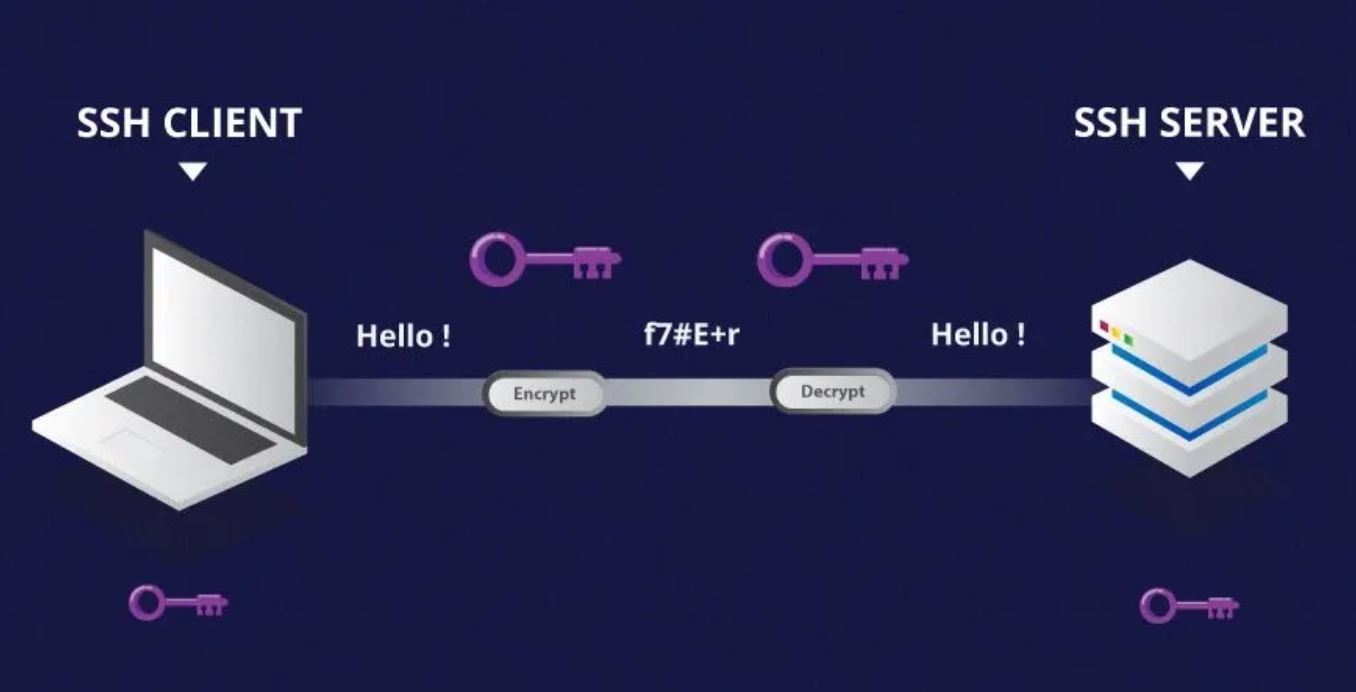Introduction
Welcome to the world of IoT (Internet of Things) devices, where countless devices are connected to the internet, sharing data and enhancing our lives in various ways. From smart homes to industrial automation, IoT has revolutionized the way we interact with technology. However, with this advancement comes the need for robust security measures to protect sensitive data and ensure the integrity of these interconnected devices.
One such security tool that plays a crucial role in securing IoT networks is Secure Shell, commonly known as SSH. SSH provides a secure communication channel, enabling encrypted data transfer and remote access to IoT devices. In this article, we will explore the importance of SSH in IoT networks and how it contributes to the overall security framework.
But first, what exactly is Secure Shell? SSH is a cryptographic network protocol that allows secure communication between two devices over an unsecured network. It provides strong authentication and secure encrypted data transfer, ensuring that the transmitted data remains confidential and cannot be intercepted or tampered with by unauthorized parties.
In the context of IoT networks, SSH acts as a protective shield, safeguarding the sensitive data transmitted between interconnected devices. By implementing SSH in IoT networks, organizations and individuals can ensure the integrity and confidentiality of their data, mitigating the risks associated with unauthorized access, data breaches, and manipulation.
Now that we understand the basics of SSH, let’s delve deeper into its specific use cases in IoT networks and the benefits it offers.
What is Secure Shell (SSH)?
Secure Shell (SSH) is a widely used cryptographic network protocol that provides a secure method for remote access and secure communication between two devices over an unsecured network. Originally developed in the 1990s, SSH has become a standard protocol for secure system administration and file transfers.
At its core, SSH utilizes a client-server architecture, where the SSH client initiates a connection request to the SSH server. Once the connection is established, SSH provides strong authentication and encrypted data transfer, protecting the confidentiality and integrity of the transmitted data.
SSH uses public key cryptography and symmetric-key encryption to achieve its secure communication. When a client attempts to connect to an SSH server, the server presents its public key to the client for authentication. The client then uses this public key to encrypt a session key, which is used to encrypt all subsequent communication between the client and the server.
One of the key features of SSH is its ability to establish secure remote shell sessions. This means that users can securely access and control remote devices or servers over an insecure network, using a terminal or command-line interface. SSH also supports secure file transfers through protocols such as SCP (Secure Copy) and SFTP (SSH File Transfer Protocol).
Besides remote access and file transfers, SSH can also be used for port forwarding, X11 forwarding, and tunneling, allowing users to securely access services and resources on remote devices without exposing them directly to the internet.
Overall, Secure Shell (SSH) is a crucial component of a secure network infrastructure, providing a robust and reliable method for remote access and secure communication. Its strong encryption and authentication mechanisms make it an essential tool in the realm of IoT networks, where data security and privacy are of paramount importance.
Use of SSH in IoT Networks
In the vast landscape of IoT networks, where numerous interconnected devices exchange sensitive data, the use of Secure Shell (SSH) is instrumental in ensuring the security and integrity of the network. SSH plays a crucial role in several key areas within IoT networks.
Firstly, SSH is commonly used for remote access to IoT devices. With SSH, authorized users can securely connect to IoT devices from anywhere in the world, enabling efficient management, configuration, and troubleshooting. This remote access capability is especially valuable in scenarios where physical access to the devices is limited or geographically dispersed.
Furthermore, SSH allows for secure data transfer between IoT devices and servers. IoT devices often generate and collect vast amounts of data, which need to be transmitted securely and reliably to backend systems for analysis and storage. SSH ensures that this data is encrypted during transit, safeguarding its confidentiality and integrity.
Another notable use case of SSH in IoT networks is secure firmware updates. As IoT devices evolve and new vulnerabilities are discovered, regular firmware updates are crucial to patch potential security vulnerabilities. SSH provides a secure channel for IoT device manufacturers to remotely deploy authorized firmware updates, minimizing the risk of unauthorized tampering or malicious software injections.
Moreover, SSH can be utilized for secure monitoring and auditing of IoT devices. By establishing SSH connections with IoT devices, administrators can securely monitor device performance, collect logs, and conduct comprehensive audits. This enhances the overall visibility and security posture of the IoT network.
Lastly, SSH also facilitates secure interconnectivity between IoT devices and external systems or cloud platforms. By implementing SSH, IoT devices can securely connect and exchange data with external services, APIs, or cloud infrastructure. This enables seamless integration of IoT devices into larger, scalable architectures while maintaining robust security practices.
In summary, the use of Secure Shell (SSH) in IoT networks is widespread and essential. Whether for remote access, secure data transfer, firmware updates, monitoring and auditing, or integration with external systems, SSH provides a trusted and secure communication channel. By leveraging SSH, IoT network operators can ensure the confidentiality, integrity, and availability of their data, enhancing the overall security posture of their IoT infrastructure.
Benefits of SSH in IoT Networks
Implementing Secure Shell (SSH) in IoT networks offers a multitude of benefits, ensuring the security and integrity of the interconnected devices and the data they transmit. Let’s explore some of the key benefits of using SSH in IoT networks:
- Secure Communication: SSH provides a secure and encrypted communication channel between IoT devices and servers, protecting the confidentiality and integrity of the transmitted data. By encrypting data during transit, SSH prevents unauthorized interception or tampering, ensuring data privacy.
- Authentication: SSH utilizes strong authentication mechanisms, such as public key cryptography, to verify the identity of IoT devices and users. This ensures that only authorized devices and individuals can establish connections and access the resources within the IoT network, mitigating the risk of unauthorized access.
- Remote Management: SSH enables remote access and management of IoT devices, providing administrators with the ability to configure, monitor, and troubleshoot devices from anywhere in the world. This remote management capability streamlines operations, reduces the need for physical access to the devices, and enhances overall efficiency.
- Secure File Transfers: IoT networks often involve the transfer of sensitive data between devices and servers. SSH supports secure file transfer protocols such as SCP and SFTP, ensuring that data transfers are encrypted and protected from unauthorized access or manipulation.
- Firmware Updates: Keeping IoT devices up to date with the latest firmware is crucial for security and performance. SSH enables secure remote firmware updates, allowing device manufacturers to push authorized updates to devices without compromising security or reliability.
- Auditing and Monitoring: SSH provides a secure means of monitoring and auditing IoT devices. By establishing SSH connections, administrators can gather device logs, monitor performance, and conduct comprehensive audits, enhancing the overall visibility and security of the IoT network.
- Integration with External Systems: SSH facilitates secure connectivity between IoT devices and external systems or cloud platforms. This enables seamless integration of IoT devices into broader architectures, allowing for data exchange, API integration, and leveraging the scalability and services provided by external systems.
In summary, SSH plays a vital role in ensuring the security and integrity of IoT networks. Its ability to establish secure communication channels, enable remote management, support secure file transfers, facilitate firmware updates, and provide auditing and integration capabilities make it an indispensable tool. By leveraging the benefits of SSH, organizations can establish a robust and secure IoT infrastructure, protecting sensitive data and maintaining the trust of their stakeholders.
SSH vs. Other Security Protocols in IoT Networks
When it comes to securing IoT networks, there are various security protocols available. One of the most widely used protocols is Secure Shell (SSH). However, it is essential to understand how SSH compares to other security protocols to make informed decisions about securing IoT networks. Let’s explore the key differences between SSH and other security protocols in the context of IoT networks:
- Transport Layer Security (TLS): TLS is a protocol that provides secure communication channels over a network. While both SSH and TLS offer encryption, authentication, and secure communication, they operate at different layers of the network stack. SSH operates at the application layer, whereas TLS operates at the transport layer. SSH is primarily used for secure remote access and file transfers, while TLS is commonly used for secure communication between IoT devices and backend systems.
- Internet Protocol Security (IPSec): IPSec is another widely adopted security protocol that provides network-level security, offering authentication and encryption at the IP packet level. In comparison to SSH, which operates at the application layer, IPSec operates at the network layer. SSH provides more granular control over remote access and file transfers, while IPSec focuses on securing the entire network traffic between IoT devices and gateways.
- Message Queuing Telemetry Transport (MQTT): MQTT is a lightweight messaging protocol commonly used in IoT networks for efficient and reliable communication between devices. While MQTT addresses the challenges of efficient data transmission, it does not inherently provide security features like encryption or authentication. In contrast, SSH ensures secure and authenticated communication and can be used in conjunction with MQTT to add an additional layer of security to IoT networks.
- Virtual Private Network (VPN): VPNs are widely used to create secure and encrypted connections over public networks. They provide secure communication tunnels between IoT devices and backend systems. While SSH establishes secure connections on a per-session basis, VPNs offer continuous connectivity and a broader network-level security framework, but with higher overhead. SSH is more suitable for specific remote access and file transfer scenarios.
- OAuth: OAuth is an authorization framework commonly used for user authentication and access control in IoT networks. It allows users to grant limited and controlled access to their resources. While SSH provides secure remote access, it does not directly address user authorization and access control like OAuth does. However, SSH can be used in combination with OAuth to provide both secure remote access and user authorization in IoT networks.
Overall, SSH offers a unique set of features, such as secure remote access and file transfers, that make it well-suited for securing IoT networks. While other security protocols like TLS, IPSec, MQTT, VPN, and OAuth have their specific use cases, SSH provides granular control and reliable security features for remote management and secure data transfers in IoT networks. The choice of the protocol depends on the specific requirements, architecture, and use cases of the IoT network.
Implementing SSH in IoT Networks
Implementing Secure Shell (SSH) in IoT networks involves several steps to ensure the secure communication and management of IoT devices. Let’s explore the key considerations and steps involved in implementing SSH in IoT networks:
- Device Configuration: The first step is to configure the IoT devices to support SSH. This includes enabling SSH functionality on the devices and generating SSH key pairs for authentication purposes. The generated SSH keys are used for encryption, authentication, and secure communication.
- Secure Key Management: Proper key management is essential for the secure operation of SSH in IoT networks. It is crucial to securely store the private keys locally on the IoT devices and protect them with appropriate access controls. The public keys should be securely distributed to the authorized users or administrators who need to establish SSH connections with the devices.
- Network Access Control: To enhance the security of SSH in IoT networks, it is important to implement network access controls. This includes configuring firewall rules, routers, and gateways to restrict SSH access to authorized IP addresses or networks. Limiting SSH access can help mitigate the risk of unauthorized access attempts and potential attacks.
- User Authentication: SSH supports various authentication methods, including password-based authentication and public key-based authentication. However, it is recommended to use public key-based authentication for enhanced security. With public key authentication, users or administrators need to possess the corresponding private key to establish SSH connections, adding an additional layer of security.
- Configuration Hardening: It is crucial to harden the SSH configuration on the IoT devices to prevent potential security vulnerabilities. This includes disabling unnecessary SSH server features, configuring strong encryption protocols and algorithms, setting session timeout limits, and implementing password complexity requirements. Regularly updating the SSH software and applying security patches is also essential.
- Monitoring and Logging: Implementing SSH logging and monitoring mechanisms helps detect and investigate potential security incidents. Monitoring SSH log files can identify suspicious login attempts, brute-force attacks, or other unauthorized activities. Implementing an intrusion detection system (IDS) or intrusion prevention system (IPS) can further enhance the security of SSH in IoT networks.
- Regular Auditing: Performing regular audits of the SSH implementation in IoT networks is critical to ensure ongoing security. Audits can involve reviewing SSH configurations, analyzing access logs, verifying SSH key management processes, and validating compliance with security policies and regulations.
By following these implementation steps and adhering to security best practices, organizations can establish a secure SSH infrastructure in their IoT networks. However, it’s important to continually assess and update the SSH implementation to address evolving security threats and vulnerabilities.
Best Practices for Using SSH in IoT Networks
Secure Shell (SSH) is a critical component in securing IoT networks and ensuring the confidentiality and integrity of the transmitted data. To maximize the effectiveness of SSH in IoT networks, it is important to follow best practices. Here are some key best practices for using SSH in IoT networks:
- Use Strong Authentication: Utilize public key-based authentication for SSH connections in IoT networks. This provides stronger authentication compared to password-based authentication, as it requires possession of the corresponding private key to establish a connection.
- Implement Access Controls: Configure proper network access controls to limit SSH access to authorized IP addresses or networks. This helps minimize the risk of unauthorized access attempts and potential attacks on IoT devices.
- Secure Key Management: Ensure the secure management of SSH keys. Protect private keys with strong encryption and store them securely on IoT devices. Safely distribute public keys and regularly rotate SSH keys to mitigate the risk of unauthorized access.
- Enable Two-Factor Authentication (2FA): Consider implementing two-factor authentication for SSH connections in IoT networks. This adds an extra layer of security by requiring a second form of authentication, such as a one-time password or biometric authentication, in addition to the SSH key authentication.
- Regularly Update SSH Software: Keep the SSH software up to date by regularly installing security patches and updates. This helps mitigate potential vulnerabilities and ensures that the SSH implementation is secure and compatible with the latest security standards.
- Configure Secure Encryption: Use strong encryption algorithms and protocols for SSH communications in IoT networks. Disable weak encryption algorithms and ensure that SSH servers and clients support the latest standards for encryption, such as AES and RSA.
- Employ Intrusion Detection and Prevention: Implement intrusion detection and prevention systems (IDS/IPS) to monitor and detect any unauthorized or malicious SSH activities. Set up alerts and notifications for suspicious activities, such as multiple failed login attempts or brute-force attacks.
- Regularly Audit SSH Configurations: Conduct regular audits of the SSH configurations in IoT networks to identify potential security weaknesses. Verify compliance with security policies, review access logs, and assess the overall security posture of SSH implementations.
- Implement Secure Network Segmentation: Consider segmenting the IoT network into separate security zones or VLANs, isolating critical IoT devices from less secure areas. This helps limit the potential impact of a security breach and reduces the attack surface for SSH vulnerabilities.
- Educate Users and Administrators: Provide training and education to users and administrators on SSH best practices in IoT networks. Promote awareness of the importance of secure SSH configurations, safe key management, and the significance of strong authentication.
By following these best practices, organizations can enhance the security and effectiveness of SSH in IoT networks. Implementing strong authentication, access controls, secure key management, and regular audits, along with staying updated with the latest security standards, helps safeguard IoT devices and the integrity of the data transmitted over the network.
Conclusion
Secure Shell (SSH) plays a crucial role in securing IoT networks and ensuring the confidentiality, integrity, and availability of data transmitted between interconnected devices. By providing a secure communication channel and robust authentication mechanisms, SSH enables secure remote access, file transfers, firmware updates, and monitoring in IoT networks.
Throughout this article, we have explored the fundamentals of SSH, its specific use cases in IoT networks, and the benefits it offers. We have also compared SSH to other security protocols to highlight its unique advantages in the IoT context.
Implementing SSH in IoT networks requires careful consideration of device configuration, key management, network access controls, and auditing. Adhering to best practices such as strong authentication, access controls, encryption, and regular software updates enhances the effectiveness of SSH in securing IoT networks.
It is important for organizations to recognize the significance of SSH in building a secure IoT infrastructure. By leveraging SSH’s capabilities and following best practices, organizations can build resilient and secure networks, protecting sensitive data and mitigating the risks associated with unauthorized access and data breaches.
In conclusion, SSH is an indispensable tool in securing IoT networks. Its ability to establish secure communication channels, enable remote access and file transfers, support firmware updates, and provide monitoring capabilities makes it a vital component for maintaining the integrity and security of IoT networks.

























